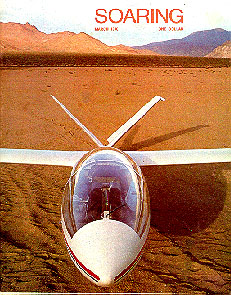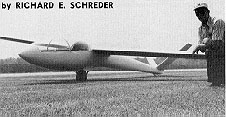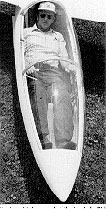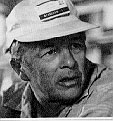
March 1976
Page 12-14
Regular tallies of SSA membership renewal forms each month have shown homebuilding articles in SOARING to be the topic of dominant interest to readers. Unfortunately, such contributions were few and far between. It wasn't until tan Hall began his popular column that the journal could scratch the homebuilder's itch with some regularity. And now with this issue, Dick Schreder has agreed to do six articles on building his new 15Meter Class HP-18 racer!
This is something of an accomplishment. Previous editors, as well as the current ones, have been after Dick to write about his sailplanes for his fellow SSA'ers. No success, until now. It wasn't that he was playing hard to get. Time was the problem. A Cessna dealership and a nationwide drafting supply business should have limited his sailplane building to a homebuilding hobby status. Except that other enthusiasts kept after him for plans and parts and help until, over the years, he gradually found himself in the kit business. Finally Dick realized that designing and building and flying sailplanes is what he likes doing best of all; to get time, he recently sold his dealership.
Still there seemed to be hesitancy to write for SOARING. What was the matter? It turned out he had read letters in the journal suggesting that some "contributions" were, in effect, free advertising. Might other members suppose that he, Dick Schreder, was trying to "use" the Society's magazine for personal aggrandizement?
That would be hard to believe. It was only recently learned that Dick's efforts to provide homebuilders with reasonably-priced kits for the HP sailplanes cost him many thousands of dollars on occasion. The prevalent "all-the-market-will-bear" rationale doesn't appear to be a part of his make-up.
He also wanted to be sure that SOARING didn't represent his series as being complete, all-inclusive, step-by-step manuals that would enable a reader to build an HP-18 from scratch. His intent is to give the enthusiast considering homebuilding a much closer detailed look at what is involved than has been possible in SOARING heretofore, and so he considers these articles to be a kind of comprehensive introduction to what it takes to build a sailplane from a kit. So come along, then meet the HP-18!
BUILDING THE HP-18 (Part One)

For several years readers have indicated that they would like to see more how-to-build articles in Soaring magazine. Editor Doug Lamont finally cornered me and extracted a promise to do a series on how to build an HP-18. This ship is the latest in a long line of gliders, airplanes, and sailplanes that I have designed and built since I finished eighth grade in 1929. My interest in building sailplanes began when I found that commercial models available back in 1954 were not as good as those that could be built by an individual.
I started building my own but by the time one was finished, new ideas and experiences convinced me that an even better ship could be built. I had never intended to get into the plans and kit business but so many people kept after me to do so that I finally gave in and soon found out what it is like to have a bear by the tail.
Some of the HP designs have been outstanding; a couple were real duds. The 15-meter HP-15 had a 33 to 1 aspect ratio and a wing loading of 10 lbs./sq.ft. It would outrun anything in the sky on the straightaway -- but everyone caught and passed me in the next thermal! The HP-17 was the other loser. It had full-span flaps and spoiler ailerons (which met the 1974 Standard Class Rules). Lateral control was less than adequate on takeoff and long periods of "up" spoiler to keep wings level in rough air had a seriously adverse effect on the glide ratio.
The HP-18's design is a distillation of the best that I have learned from all of the other HP's. It should be the equal of any 15-meter ship now on the horizon. It's mixed metal, glass, foam, and exotic-fiber construction will give it a weight advantage over all-metal or all-glass ships.
This ship is designed for the new 15-Meter Class which should become the most popular class, because size, weight, and cost are held down by span restriction. Since there are no other rules for officialdom to tamper with, ships in this class have a guaranteed future never enjoyed by Standard Class ships which are threatened with obsolescence by never-ending rule changes.
The design of the '18 is such that improvements, variations, or repairs can be made easily. As an example, it is possible with the HP-18A to reduce the basic 450-lb. empty weight to approximately 350 lbs. by use of carbon fiber main wing spars, a Kevlar fiber fuselage pod, and thinner wing and tail skins. Use of exotic fibers increases the kit cost but saves about 200 man-hours. Since the average amateur has more excess time than money, such an option poses a difficult decision. Either way, the HP-18 has performance second to none and offers a low-budget solution to the pilot with limited income.
So what does it take to build an HP-18? The man who wants to put his own '18 together doesn't have to be a master machinist or metal smith, but he should have at least average mechanical ability. Previous experience is helpful, of course, but if he doesn't have any, he should find someone who can show him how to rivet and help him if he gets stuck. In addition to the usual hand tools, a builder will need an air compressor, a rivet gun and sets, clamps, a drill and bits, cleco pliers and fasteners, and access to a drill press and band saw. No jigs or fixtures are required, and templates, drawings, and instructions are supplied with the kit.
Two important things that are needed are a place to work and the time to work. A workshop ought to be twenty-five feet long and should be capable of being heated to 700 during gluing operations. The builder must be able to devote 500 to 1500 man-hours to complete the job. (Time required will vary according to experience and ability.)
It should be emphasized that the '18 can't be built from the plans alone. Detailed dimensions are not included for parts that are already made or that have been scribed on material in the kit. The prints are intended to help in assembly only.
All parts that must be bent, machined, formed, routed, heat treated, or welded are completed. But the builder will have to saw, trim, file, fit, drill, bolt, rivet, and glue during the assembly of parts. Everything is included in the kit except paint, radio, and instruments.
|
 The joy stick is gone, but the joy isn't. Dick says it's fun flying the '18 with his right hand on the truncated, side-mounted version of the control column. The trim tab and brake are controlled there, too. His left hand is resting on the flap handle. Automatic flap settings for minimum drag cruise control are obtained by using the flap handle for elevator control. Instrument pylon is not installed in this photo. The joy stick is gone, but the joy isn't. Dick says it's fun flying the '18 with his right hand on the truncated, side-mounted version of the control column. The trim tab and brake are controlled there, too. His left hand is resting on the flap handle. Automatic flap settings for minimum drag cruise control are obtained by using the flap handle for elevator control. Instrument pylon is not installed in this photo.
|
The procedures for licensing a homebuilt sailplane with the FAA are not difficult. The Administration's Records Division in Oklahoma City will issue an "N" number and registration certificates upon receipt of five dollars and a notarized statement certifying the purchase of a complete lot of materials for building a model HP18 sailplane, serial no. X. The FAA's local General Aviation District Office (GADO) or Engineering Office will conduct progress inspections and, upon completion, will issue an FAA Experimental Airworthiness Certificate in the Amateur-Built Category-if the inspectors are satisfied with the workmanship. There is no charge for these inspections. The ship is usually restricted to a 25-mile radius for five or more flights (at the discretion of each inspector).
Questions are asked about insurance of sailplanes licensed in the Experimental Category. Hull insurance rates seem to be about the same and most life insurance policies are not affected adversely. AOPA recently included coverage of homebuilt flying where it had been previously excluded. The Experimental Category has its advantages in that the builder can conduct his own maintenance, repairs, alterations, and inspections without the expense of hiring an A & P mechanic. Also, annual re-licensing is done by a GADO inspector without charge.
Before getting into construction details and procedures, let's look at the design goals and list the specifications of the HP-18 (see box). The prime aim was to reduce drag and weight to produce a superior competition machine with gentle flight characteristics. Cross-country efficiency is improved by the use of a low-profile fuselage, better gap seals, new wing tips, faired tail wheel, and better streamlining. Flaps and ailerons are coupled together to increase cross-country speed. Ninety-degree flap capability permits steeper landing approaches and slower, safer touchdown speeds. Direct rudder cable connections to the tail wheel give positive steering control on the ground at all speeds. Water ballast is carried inside the wings' box spars. Special attention has been given to pilot comfort and ease of assembly.
In terms of construction the goal has been to develop a machine that is rugged yet not too complex for a builder with average mechanical aptitude. Here are eleven features that help simplify the homebuilder's task:
1. Main wing spars with caps pre-machined from solid aluminum plate stock.
2. Elimination of most wing skin riveting by use of precut, structural foam ribs spaced every four inches.
3. Prefabricated fiberglass fuselage pod.
4. Simplified aluminum fuselage tail cone construction.
5. Simplified assembly of front and rear fuselage sections.
6. Preformed canopy and frames.
7. Completion of landing gear, controls, and other welded items.
8. Fiberglass wing tip skids and tail fairings.
9. Prefabricated control cables.
10. Pre-forming and heat treating of all parts where required.
11. Complete supply of rivets, bolts, nuts, washers, cotter keys, cement and all other necessary parts. Paint and instruments are not included in the kit but can be supplied at extra cost.
No complicated jigs are required. Wings and tail surfaces are built on a table. Templates are provided for checking proper alignment. A 24-inch steel drill guide is furnished to facilitate drilling accurately spaced holes.
How does it fly? Well, I flew the HP-18 for a total of 126 hours last summer and found it to be an easy ship with no bad habits. It performs like a PIK-20 at equivalent loadings, but the '18's area is larger and empty weight lighter, so the '18 will climb better, approach steeper, and land slower. The cockpit is very comfortable on long flights, and I especially like the side-mounted control stick with attached brake handle and trim tab. Although the fuselage is only 27 inches deep, the forward visibility is excellent. It has accommodated 6 ft., 4 in., 250-lb. pilots. With 180-lb. pilots wearing a 16-lb. chute, the '18 flies at 60 knots at zero trim.
We supply a standard instrument package at extra charge if it is desired. It includes two Ball electric variometers mounted at the top of the panel. One of these is set to tell the pilot what the outside air is doing (Netto). The other shows him how to fly at the most efficient speed if he keeps its pointer on "O" (cruise control). Automatic flap settings for minimum-drag cruise are obtained by using the flap handle for elevator control. A variable-pitch audio speaker gives a steady tone on up indications and a chopped (intermittent) signal during downs. This unit can be switched to either vario while other switches and duplicate power supplies will take care of potential failures.
|

The author has had a lifelong interest in flying. He soloed, without instruction, during his high school days in an original hang glider. Then followed a factory-built primary glider purchased for $9.70 and a self-designed and built airplane powered by a motorcycle engine. He graduated in 1938 from the University of Toledo with a Bachelor of Mechanical Engineering degree. The next six years were spent flying as a naval aviator from 1939 through World War 11. During the last two years he was class desk officer of the PBY flying boats. As Lt. Schreder, he was awarded the Distinguished Flying Cross for action in the North Atlantic and left the U.S. Navy with the rank of Commander. After the war, he resumed his hobby of building airplanes. A chance flight in a World War 11 "Cinema" sailplane in 1954 switched his interest to sailplanes and the HP designs started rolling out at the rate of about one per year. He held the 100, 200, and 300 km single-place world sailplane speed records at one time. He was U.S. National Soaring Champion in 1958, 1960, and 1966. He was on the U.S. International Team in Germany, England, Argentina, and Poland. Dick received the Larissa Stroukoff Memorial Trophy in 1958, 1959, 1960, 1961, 1963 and 1965; the Lilienthal Medal in 1959, and the Warren E. Eaton Memorial Trophy in 1962. He has built one hang glider, 4 airplanes, and 13 different sailplanes. |
Beginning next month, Dick Schreder will be getting in the first article of his series on the nuts & bolts specifics of building the HP-18. These will be on the tail surfaces, the flaps and ailerons, the wings, and the fuselage. The last article will detail the construction of a 625-lb. aluminum trailer especially for the '18.
Costs are not mentioned in the above article. This brings us back to where we started, and to spare our author the onus of suspect commercialism, the editor would have it known that a complete HP-18 kit sells for $5495 F.O.B. from Bryan Aircraft, Inc., Box 488, Bryan, Ohio 43506. Individual kits containing the unit assemblies, drawings, and instruction sheets range from $225 for the tail to $2670 for the fuselage. For the impatient, informational brochures on the HP-18 or HP-18A kits are available for five dollars from Bryan Aircraft, Inc. |
HP-18 SPECIFICATIONS
Span (Wortmann FX 67-150 airfoil):49.2 ft. - 15.00 m
Length: 23.2 ft. - 7.07 m
Height from ground at tail, tail extended: 48.0,in. - 1.22 m
Height from ground at tail, tail folded: 62.0 in. - 1.58 m
Cockpit: Width 24.0 in. - .61 m
Depth: 27.0 in. - .69 m
Length: 70.0 in. - 1.78 m
Wing Area: 113.0 sq. ft. - 10.50 sq. m
Flap Area: 16.5 sq. ft. - 1.53 sq. m
Ailerons Area: 6.1 sq. ft. - .57 sq. m
Stabilizers Area: 8.5 sq. ft. - .79 sq. m
Ruddervators Area: 7.0 sq. ft. - .65 sq. m
Aspect ratio: 21.4
Dihedral: 2.3'
Twist 0.
Taper ratio: 2/1
Flap settings: -10, to 90,
Weights -
Wing panels: 135.0 lbs. - 61.24 k
Fuselage, tail, radio & instruments 180.0 I lbs. - 81.65 k
Total empty: 450.0 lbs. - 204.12 k
Pay load: 300.0 lbs. - 136.08 k
Water ballast, maximum: 200.0 lbs. - 90.72 k
Normal gross: 750.0 lbs. - 340.20 k
Maximum gross with ballast: 950.0 lbs. - 430.92 k
Wing loading: 170 lb. pilot, 16 lb. chute: 636 lbs., 5.63 psf - 27.49 ksm
Normal maximum: 750 lbs., 6.64 psf - 32.42 ksm
Ballast maximum: 950 lbs., 8.41 psf - 41.06 ksm
Maximum airspeed: Rough air; 120.0 mph - 193.12 kph
Smooth air or rough air with flaps up; 150.0 mph - 241.40 kph
Aero tow; 120.0 mph - 193.12 kph
Winch or auto tow; 90.0 mph - 144.84 kph
L/D Maximum: 40/1
Minimum sink, 636 lbs., 50 mph, 1.8 fps - .55 mps
Stall speed: 0 flap, 750 lbs., 40.0 mph - 64.37 kph
Stall speed: 60 flap, 750 lbs., 35.0 mph - 56.33 kph
The joy stick is gone, but the joy isn't. Dick says it's fun flying the '18 with his right hand on the truncated, side-mounted version of the control column. The trim tab and brake are controlled there, too. His left hand is resting on the flap handle. Automatic flap settings for minimum drag cruise control are obtained by using the flap handle for elevator control. Instrument pylon is not installed in this photo.